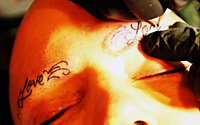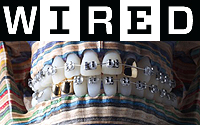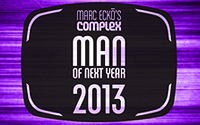
.jpg)

When I visited Jonathan LeVine Gallery the day before the opening of Jesse Hazelip’s “Love Lock: Cycle of Violence,” the gallery was abuzz with pre-installation fervor. Framed ballpoint drawings lay, meticulous arranged, on the gallery floor, later to be made vertical. Other works—printed wheatpaste cutouts on bold stenciled backgrounds and reclaimed wood panels from an abandoned prison in Upstate New York—leaned gently against the walls. “Love Lock,” documenting the injustices of the American prison system, is Hazelip’s first solo exhibition in New York.
A graffiti artist who grew up in Colorado and later in Southern California, Hazelip considers himself an activist. Calling attention to social injustices he perceives, most recently, the cruel tactics of for-profit prison corporations and their masquerades as “rehabilitation” centers, he creates work to spread awareness to the greater public. “I’m not just making pretty pictures,” he emphasizes.
 Image via Jonathan LeVine Gallery / Jesse Hazelip Plea
Image via Jonathan LeVine Gallery / Jesse Hazelip Plea
‘Seeing graffiti—and I’ve always been interested in gang graffiti—has informed my graffiti. It’s impossible for me not to be influenced by that.’
Of course, the images he creates are still visually enticing. His intricate and masterful paintings and pen drawings of butchered and tattooed bulls, wolves regurgitating chains, and helmeted vultures, all set against bold backdrops of stenciled script or prison blueprints, read as puzzles—overlaid symbols awaiting interpretation. Incised bull skulls recall other artists’ images of Hazelip’s native Southwest, Americana inscribed with “Cholo-style” tattoo markings. “My most formative years were in Southern California, and there were [Cholo-style] tattoos everywhere,” he explains. “I try not to use only those types of motifs, but they’re in my mind because I grew up with them. Seeing graffiti—and I’ve always been interested in gang graffiti—has informed my graffiti. It’s impossible for me not to be influenced by that.”
This show also debuts Hazelip’s first performance and site-specific installation, a six-by-nine-foot Plexiglas prison cell, corresponding to the standard size for solitary confinement. During the exhibition’s opening and during specific “visitation days” over the duration of the show, Hazelip inhabited the cell with longtime friend Bianca Casady of CocoRosie, who treats the prison system in her own artwork. The name of Casady’s and Hazelip’s artistic collaboration, Twin Rivers, can be read in the stenciled text of many of the show’s works.


Photo by Adam Wallacavage / Jesse Hazelip and Bianca Casady Twin Rivers
Far away from New York from a prison cell in Mississippi, Hazelip’s good friend and collaborator James Allison will not be present for the opening, despite collaborating on many of the show’s works. In many ways, James Allison seems to serve as both a participant and the initial inspiration for “Love Locked.”
‘I feel on some level that prisoners are paying for the sins of society. We’re failing our youth in education and sending kids to jail at age thirteen.’
As a graffiti writer, Hazelip has had a few of his own legal run-ins; he served his first few days in jail in 2002, on a graffiti arrest, and the experience of being ordered and herded around by sheriffs and corrections officers gave Hazelip his first taste of perceived injustices behind the prison system’s bars. It wasn’t until about five years ago, however, when Hazelip was working in the Bay Area on pieces related to the wars in Iraq and Afghanistan, that he really began considering a body of work about prisons. Then, on the morning of Hazelip’s son’s baby shower, Hazelip learned of Allison’s arrest: “That just kind of expedited the whole process for me; it made it more urgent.”
After Allison’s incarceration, the two began writing to each other. “I had the idea of sending him drawings that we could work on together, so we’ve been doing those over the last five years; we’ll just go back and forth.” Some of these collaborations are included within the show.
According to Hazelip, Allison has been transferred three times and has struggled to maintain contact with his family. Jesse says, “I had this sense that tons of people were writing him [in prison], but it turns out that I’m the only one. That just broke my heart. Our relationship has gotten a lot deeper since he’s been in prison.” He clarifies, “I’m not trying to say, ‘Free everybody!’ I do believe that people need to pay for crime, but I believe that there are healthier ways that would benefit society.” He continues, “I feel on some level that prisoners are paying for the sins of society. We’re failing our youth in education and sending kids to jail at age thirteen.”

Hazelip’s voice cracks a bit in saying this, a display of emotion that contrasts wildly with his appearance. A tall, thin man, clad in a red flannel and black jeans covered in wood shavings, Hazelip has shaved his eyebrows, which are now replaced with scripted tattoos reading “Love Lock,” one word over each brow. A ouroboros, a snake eating its own tail, twisted into an infinity sign, now adorns the back of his newly shaved head. Remaining unseen, to me at least, are Hazelip’s new forearm tattoos, reading “Nique la police” or “Fuck the police,” in a script readable from a handcuffed position. “I’ve never done anything like this before,” Hazelip admits.
‘Many people call facial tattoos ‘a cry for help,’ and in this case, they are, not for me but for the men, women, and children affected by this system.’
Hazelip’s choice to tattoo his body displays the gravity of the issues he confronts. On one level, Hazelip’s tattoos, especially when seen in his installation, confront viewers with the aesthetic of incarceration: confinement, tattoos, and “gang” aesthetics. On another, the process of tattooing, like being incarcerated, becomes embedded within a person; one choice, one moment, can mark a person for life. One felony drug possession can cost someone their right to vote, rights to public assistance for them and their family, and the ability to find (legal) work.
“The connection with tattooing is interesting because Michelle Alexander, the author of The New Jim Crow, refers to incarceration as ‘the mark of Cain,’ and I found that a profound association. Losing your right to vote is actually one of the least severe practical losses…Many people call facial tattoos ‘a cry for help,’ and in this case, they are, not for me but for the men, women, and children affected by this system,” says Jesse. And of course, one can’t consider prison tattoos without thinking about Pelican Bay, the prison in Northern California, where authorities have notoriously considered tattoos to be “proof” of gang affiliations, and thus, justification for punishment.
Within Hazelip’s practice, the shift from marking walls or boards to altering his own body marks a new direction for his work. In addition to getting tattooed, Hazelip has been participating in an exercise regimen confined to “prison-like” spatial conditions in preparation for the show: “I do it all in my house. I’ve been sculpting myself…,” he says. “That idea is still building, but I’m wondering just how deeply I can throw myself into this concept and be as effective as possible in bringing attention to these causes.”
 Jesse Hazelip Hole
Jesse Hazelip Hole
One of the pieces in the show, Hole, serves as a point of connection between Hazelip’s performance and graffiti work. The work, comprised of a technicolor wolf attached to painted boards taken from an abandoned prison, connects Hazelip’s wheatpaste practice with his body and the site-specific nature of graffiti. Attaching sandpaper to his feet, Hazelip scratched concentric circles into the paint by pacing in circles within the boards’ horizontal space.
‘Wheatpaste has been a medium of protest since its inception.’
Referencing the psychosis resulting being confined, these scratches serve as a subtle reminder incarceration’s dual effects on the body and mind. Another work, Christo, documents sacrifice. Featuring a severed and tattooed bull head with a webbed halo against a background of stenciled red and black lettering, the work sits in a frame inlaid with the objects that one might want during incarceration: a print of a baby’s feet and family photographs, but also razor blades.
With a message of civil disobedience, an artist must be careful in translating work from the street into the gallery, a space flooded with the connotations of invisible economic and power structures. To Hazelip, the gallery has acted as a forum for exchange, a place to share his opinions with a new audience: “It’s important to have discussions with people in power who have money. Hopefully [these people] won’t buy a work just because it’s cool, but because the underlying message will inform them, and maybe they’ll have a friend who can make a difference. I want to talk to everybody.”

Jesse Hazelip Plea Study
‘It’s very important to me to do work on the street, because I want to involve the community.’
One recurring feature of Hazelip’s gallery work is the continued use of wheatpaste, an adhesive used primarily within graffiti to tack images to walls. “Wheatpaste has been a medium of protest since its inception,” Hazelip explains. After growing wary of the cliquey and unfocused nature of protests, wheatpaste and its associations with illegal posting became Hazelip’s medium of dissent.
Even as Hazelip’s works appear in the gallery, the influences and techniques of graffiti–spray paint, stencils, symbolic words and motifs, remain prominent. Hazelip still considers graffiti to be his primary means of expression: “It’s very important to me to do work on the street, because I want to involve the community. I don’t want to speak only to the gallery world, and so the activism of work is civil disobedience and in pressing issues [like this]. If everybody is walking in line, nothing is going to change.” He adds, “I think that people just need to be more forgiving, more compassionate.”
The show will be up through February 8, 2014 at Jonathan LeVine Gallery.
http://www.complex.com/art-design/2014/01/jesse-hazelip-jonathan-levine-gallery







